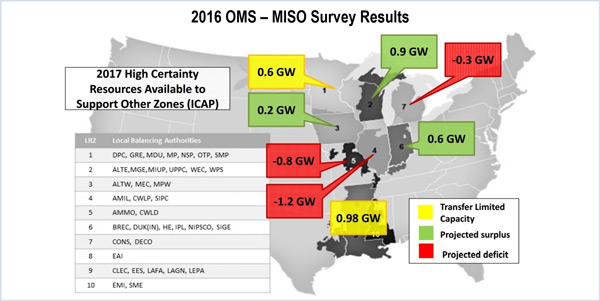By Amanda Durish Cook
CARMEL, Ind. — MISO will roll a 35% share of the capacity from resources sitting in the definitive planning phase of its interconnection queue into the annual resource adequacy survey conducted with the Organization of MISO States — over the objections of some stakeholders who seek inclusion of a greater portion of capacity.
The survey currently counts only future resources that have already executed a generator interconnection agreement.
Indianapolis Power and Light’s Lin Franks said MISO’s 35% completion estimate is too conservative, especially when considering projects submitted by state-jurisdictional utilities that are obligated to serve load and whose projects might be more reliably completed than other queue entrants. (See Stakeholders, MISO at Odds over Resource Adequacy Survey.)
“You know the damn thing is going to be built — it needs to be included” in the survey, Franks remarked during a March 8 Resource Adequacy Subcommittee meeting.
She also warned of the “self-feeding” problem of developers entering the queue long before they are certain that a resource will be constructed — the product of long queues.
Franks suggested that MISO examine rates of withdrawal based on resource type.
“If you don’t take a look at which resources are withdrawing, you don’t have a transparent picture,” she said. “You’ve got to be more transparent and not convince people that the sky is falling.”
Madison Gas and Electric’s Gary Mathis said he did not see evidence of stakeholder advice in MISO’s proposed improvements.
“This issue has been around for a number of years, and MISO has been aware for a while of the improvements that are needed. … Certain projects in the queue will be realized,” he said. “I’m disappointed that we didn’t come further, and I question whether we were listened to in this process.”
The RTO says it will consider adding more resources in other phases of the queue as it carries out queue reforms.
Darrin Landstrom, MISO’s resource forecasting adviser, said the terms “committed” and “potential” will replace the “high certainty” and “low certainty” descriptors currently used for resources in the queue’s definitive planning phase.
Bonnie Janssen, a Michigan Public Service Commission staffer, said OMS could additionally include a “probable” category. MISO will send out questionnaires by March 31, with detailed results expected to be released in June.
Laura Rauch, manager of resource adequacy coordination, said MISO can provide stakeholders with mockups of survey results at the April RASC meeting.
RASC Chair Chris Plante plans to present MISO and stakeholder differences over the survey’s improvements to the Board of Directors during its March 23 meeting.




